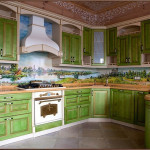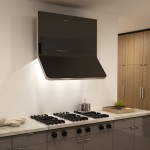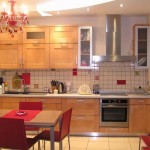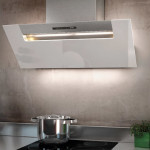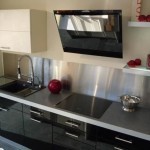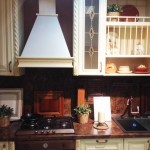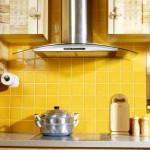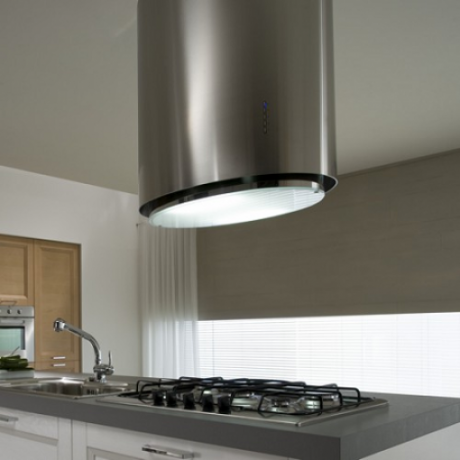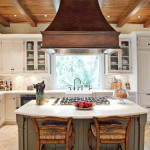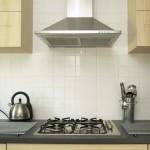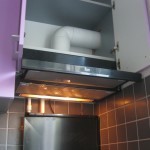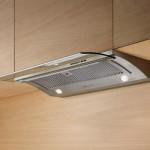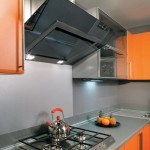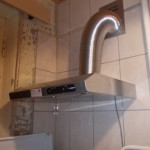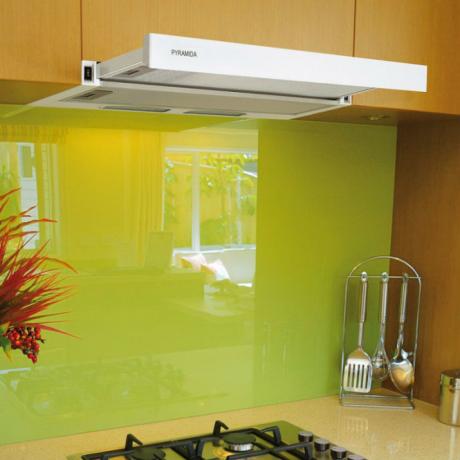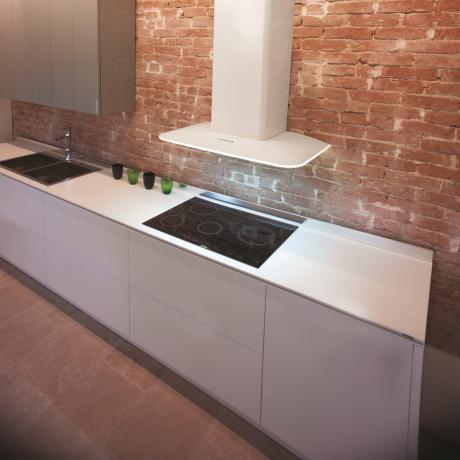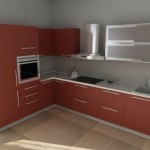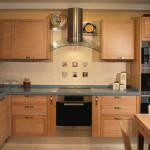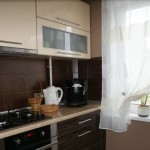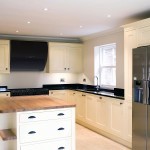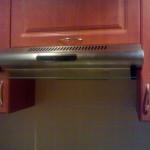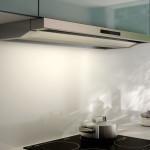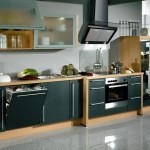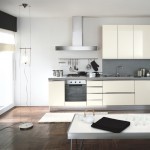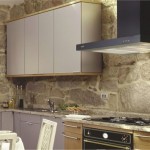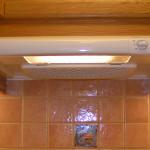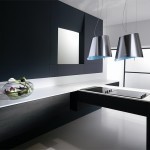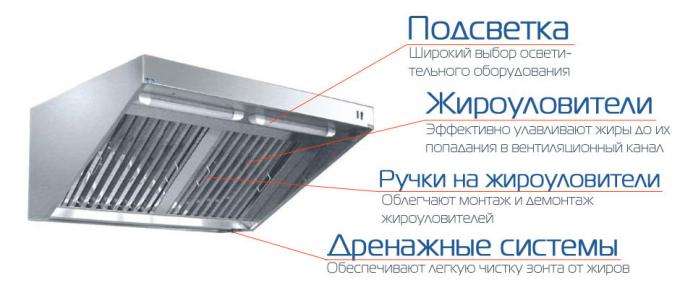Content
-
1 What you need will be
- 1.1 Announce the entire list, please
- 1.2 Not only in appearance, but also in touch
- 1.3 Your way out, citizen calculator
- 1.4 A little more technology
- 1.5 Installation is not a question, but there are nuances
- 1.6 Finally
How often do you buy something, knowing all the necessary information about it? Admit to yourself that not often. In the case of choosing a hood, there cannot be much information.
After reading our material, you will be able to fully navigate that sea of models and their types, as well as to unmistakably choose the product that is right for your kitchen.
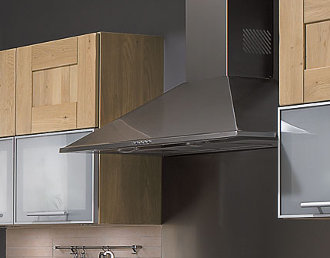
Hood - will save you from unnecessary odors in the kitchen.
So how to choose the right range hood for your kitchen? Very simple.
Our instructions will solve this problem in three steps:
- Step one - read and make a decision;
- Step two - check the parameters of your kitchen and deduce your standards;
- Step three is an informed purchase.
What you need will be
No matter how manufacturers divide the hoods by appearance, type of installation (we will also talk about this), but the first division that you need to know is the division by type of work.
Kitchen hoods are of two types:
- Using an exhaust type of work;
- Using a recirculation type of work.
There are products that combine the above principles, therefore they are distinguished into a third, almost independent, type - using a mixed type of work.

Exhaust type.
- Exhaust the type of work. During the operation of these systems, all fat, steam and everything that accompanies the cooking process is irretrievably released into the atmosphere. This will certainly add weight to this system when choosing and buying hoods, but keep in mind that: together with the vapors, the heat also leaves your home, which is less desirable, especially on a winter, frosty day.
Note! When installing a hood with this operating mode in kitchens with plastic windows and doors, it is necessary to think over and equip an external air supply system. If this is not possible, this type of hood is not for you. A recirculation hood will solve your problems.
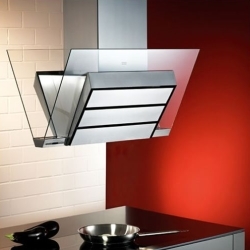
Recirculation type of hood.
- Recirculating the type of hood is most convenient for kitchens with plastic double-glazed windows and plastic doors. The fact is that the air, having passed through the cleaning system and leaving grease, soot, etc. on the filters, returns to the room. There is no heat loss. Does not require binding of the slab to the ventilation window and shaft. But this system also has drawbacks that must be considered when purchasing. The charcoal filters in the housing require periodic replacement, therefore, capital investment.
Which hood for the kitchen to choose among the many - see here.
Announce the entire list, please
We announce. To choose a hood for the kitchen, we invite you to get to know them better.
We have kitchen hoods of the following types and designs:
- Suspended;
- Embedded;
- Wall mounted;
- Corner;
- Island.
And now the same, but in a little more detail.
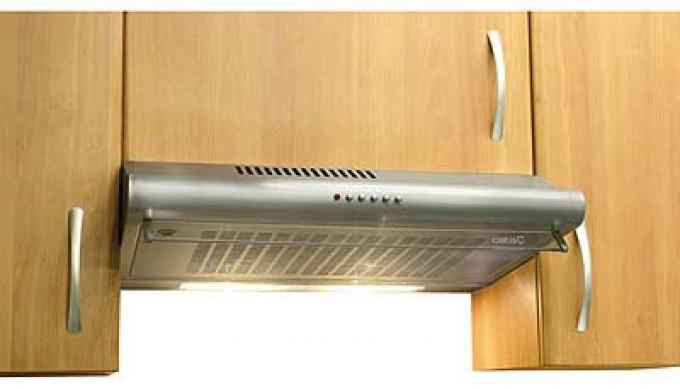
Here it is - a suspended hood
- Suspended hoods, they are flat, they are also standard, are intended for use in a single ensemble of the second floor of a kitchen unit and, as a rule, are hung from a kitchen cabinet. If you have kitchen cabinets above the stove, then look at the photo - this option is yours.

Built-in hood.
- The built-in hood allows you to fit (build) yourself into an interesting, individual suspension system. This hood allows you to experiment and find unexpected design solutions for kitchens. If you are determined to hide this functional element, not to advertise it in the interior, please - here's a ready-made solution.

Wall-mounted hood.
- For people who prefer to highlight the location of each item: if it is a locker, then this is a locker; if it is a cooker hood, then it is a cooker hood, imagine a hood in retro style. Wall or chimney hood fits perfectly into the interior, is both an independent (solo element) and an excellent member of the ensemble. You have decided to add retro colors to the kitchen palette - please, the wall hood is your decision.
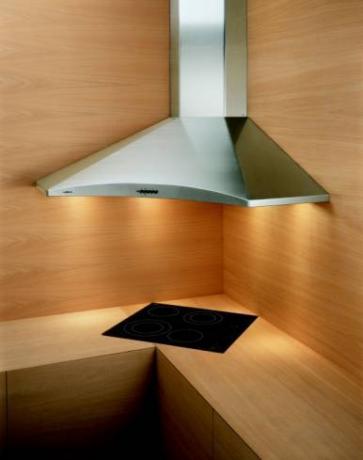
The corner hood is self-explanatory.
- And really, what kind of explanation is required here. You decided to put the stove in the corner of the kitchen so that it does not interfere. And the cooker requires a hood, please get your hood.

Islands, islands - kitchen romance.
- Island hoods are necessary in large kitchens with a central or island type of placement of stoves. The design of these hoods is dominated by the recirculation type of work.
Not only in appearance, but also in touch
In order to close the question about the species, let's go through the materials from which the hoods are made.
After reading them, you will understand the essence of such an issue as pricing. After all, the price of a product directly depends on the material from which it is made.
For the manufacture of hoods are used:
- Stainless steel;
- Stainless steel with enamel;
- Powder coated stainless steel;
- Heat resistant plastic;
- Wood;
- Material combinations.
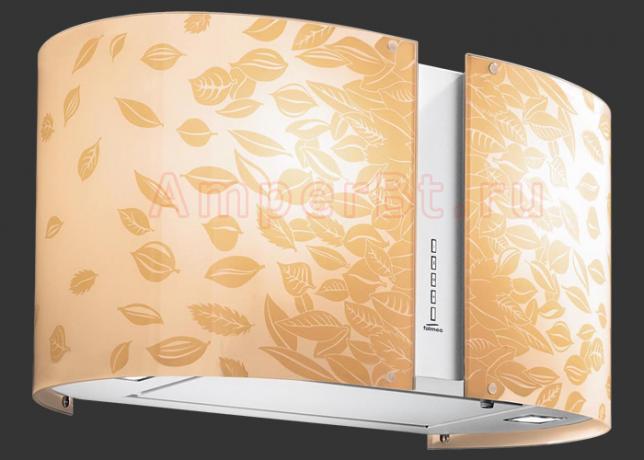
And here is the combination.
Your way out, citizen calculator
We have already decided how to choose a hood for the kitchen by fitting it into the interior. Now let's move on to solving an equally important set of issues - technical.
Unfortunately, little attention is paid to it in everyday life, but this is your guarantee against so many disappointments and losses, including when buying a hood for the kitchen.
We dare to assure you that there is nothing complicated in this, and the calculations that we suggest you carry out do not go beyond the school course. The only thing that can come in handy is a calculator, a piece of paper and a pen.

To select a hood, a calculation is required.
We will derive our standards.
You never wanted to be a trendsetter, well, at least, in some area, to introduce your own standards. If so, now you can do it. Choosing your hood for your interior, you can accurately determine its technical parameters.
Let's start:
- The first thing we need to define and standardize is the dimensions of your future hood. Everything is very simple here, we will measure the length of our plate and write it down in the register of standards. When choosing a hood, this parameter will be taken into account first. The dimensions of the hood must fully correspond to the size of the plate.
Note! The use of a larger hood is allowed, however, a smaller hood will not be able to fully ensure the capture of the plate area, and, consequently, the removal of the entire volume of air.
- Let's derive the second standard and write it down on paper. This mathematical calculation will be somewhat more complicated than the previous one, but as we promised, it does not require complex mathematical models of the solution. Let's calculate the required extraction performance. Each product is capable of passing only a certain amount of air through itself, and this is due to the design capabilities of the hood motor. When buying this kitchen assistant, you will need to compare what this girl can do and what you need. And what exactly do you need? Make a simple calculation.

The cheat sheet is ready.
Note! You need to look at the formula below and substitute your parameters. Calculation of the formula: sufficient performance for your kitchen = the volume of this kitchen multiplied by the matching factor (this is from us) and multiplied by the factor 1.3.
The volume of your kitchen can be measured quite simply, as is the volume of any geometric body with height, width and length. Calculation method: length X width X height.
Let's say you're in luck and your kitchen is spacious and tall. And the ceilings are what you need. Let's translate this into the language of numbers: height - 3 meters, length - 5 meters, width - 3 meters. Kitchen volume = 3 * 5 * 3 = 45 cubic meters.
Now the coefficient we promised: for kitchens it is 12. Do not bother yourself where it came from, it is calculated and hammered into building codes.
So, 45 multiplied by 12, we get - 540, and, multiply by 1.3, we get - 702. 702 is the estimated capacity of the hood, less will not suit you.
And no matter how beautiful and extravagant it looks for the above volume of the room, there will be no sense from it.
Now we will measure our parameters with a tape measure and insert them into the formula - the second result is ready. When buying, compare the performance of the unit with your calculations.
For the most meticulous, a few explanations about the coefficient 1.3. This coefficient is derived experimentally for multi-storey buildings.
In fact, it shows the efforts required to pump the initial volume through the air removal system. Note! For a private house, the coefficient 1.3 can be omitted.
You have created standards that are right for you, applicable only to your kitchen. Congratulations, here you are, your own standards setter.
Read also the article on installing the hood in the kitchen according to the rules.
A little more technology
Can we close the question of how to choose a kitchen hood without telling about the noise and installation features? And is it important. You don't want your hood to make noise like people at a rally, of course not. So read on and compare.
According to technical and hygiene standards, the level of noise emitted by household appliances should be classified as low.
Therefore, for its quantitative and more understandable display, a value of 65 dB was introduced. And for clarity, we will give a few more values. A washing machine during centrifugation can make noise up to 68dB, a refrigerator - up to 43dB, a TV set at medium power - up to 60dB, and an air conditioner - up to 45dB. But the scream of a person is already 90 dB.

Keep quiet.
Another important detail. Very often, the hood is the final element that you have to fit into the existing furniture and composition.
Therefore, a dilemma arises of what to do: either pull the ventilation ducts through the entire room to the ventilation shaft, or go to install a recirculation system.
The choice, of course, is yours. The so-called PVC ducts, which are made of heat-resistant plastic, are quite thin and can easily lie on the entire structure of the cabinets and go up to the ventilation window.
But to cover this channel will help a decorated bar, as in the previous photo. But with the recirculation system, no additional cover is required. In these cases, the price issue is the price of the product and your tastes.
Installation is not a question, but there are nuances

The drawing is small, but the sense is big.
Note! Do-it-yourself installation of a hood requires knowledge of several parameters. So the electric hood should hang over the stove by 50 centimeters, over the gas - by 65. You can, of course, place the hood at a higher height, but remember: increasing the standing height of the hood you proportionally reduce its power.
And a little more about technology. First launch of the product. This is the main controller of the installation and performance.
At the same time, it is estimated:
- Correctness of installation due to the absence of characteristic rattling. If it is, it is necessary to more tightly attach the product to the wall, or strengthen the retaining structures.
- Correct installation and integrity of the outlet system. Escaping air must not seep through PVC duct elements or corrugations. Otherwise, the elements must be replaced.
Note! The air transmission can be determined by the deflection of the candle flame over the product.
Finally
We have gone through two steps out of the three outlined. In the above material, we have shown the main types of hoods and the parameters for their selection.
The last step you have to do yourself is to buy. And to support and consolidate the material, watch our video instruction, it will allow you to take the third step quickly and efficiently.
Which hood for the kitchen is better - see here.
Gallery

